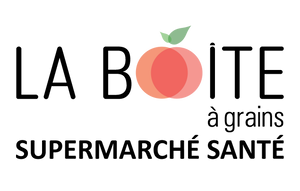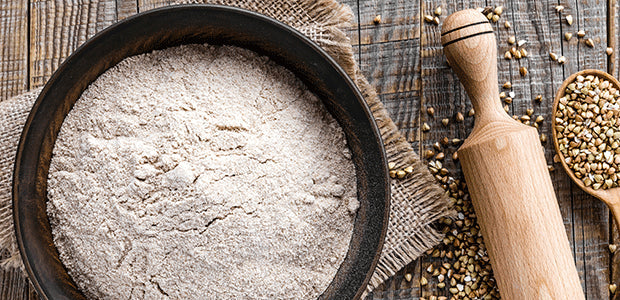No food is more appreciated in the four corners of this round planet than bread.
When we say bread, we think of one ingredient in particular: flour. Long before we break bread with friends, let's go back to the raw material that accompanies almost all our meals, and talk about wheat, khorasan, quinoa, sorghum and more.
Different flours, different uses
From its Latin name (farina), flour means "wheat, spelt", but its origins go back to the beginning of man's sedentary lifestyle and agriculture. Flour is the result of a single gesture: "grinding the grain". Whether in the beginning on a stone millstone, in a windmill or today in a factory in the center of an industrial megalopolis, flour is ground.
Depending on geographical location and agricultural crops grown, the Chinese will use more rice flour, the Peruvians more quinoa and corn, and the Canadians more wheat.
Wheat (all-purpose white flour)
With gluten. The best-known and most common flour, found in all our grocery stores. Made from a blend of various soft and hard wheat flours, it's the one most often used in our kitchens to make bread, cakes, doughnuts and pie dough.
It should be added that it is because it contains gliadin, a mononumeric, insoluble protein that is part of gluten, which makes dough rise, that some people are predisposed to develop intolerance and suffer from celiac disease.
By the way, if the question of "gluten sickness" touches you, we encourage you to read our previous articles on the site of La Boite à Grains site, which are packed with relevant information that sheds light on this health problem to which we are becoming increasingly aware through the media, and which affects a significant proportion of the population:
http://www.laboiteagrains.com/trucs-et-conseils/ce-quil-faut-savoir-sur-le-gluten/
• Starch (68-72%): present in all cereals, this complex carbohydrate thickens béchamel sauce, for example.
• Gluten (10-12%): protein mixture that makes dough rise
• Water (15-16%)
• Sugars (1-2%): sucrose and glucose, which drive fermentation
• Fats (1.2-1.4%): found in the germ and husk, but very little resistant to grinding
• Mineral matter (0.5-0.6%): phosphorus, potassium and magnesium are used to quantify and qualify its purity.
• Vitamins negligible amounts of vitamins B1, B2 and E.
Spelt
Low gluten content. Appreciated for its nutty taste, it is used in bakery products, pasta and cookies. It is richer in protein, magnesium, zinc, iron and copper than wheat flour.
Khorasan (Kamut)
With gluten. Native to northeastern Iran and the Fertile Crescent, khorasan wheat, whose registered trademark is Kamut, has a very high nutritional value, rich in selenium, which fights free radicals and helps the cardiovascular system. It contains 20% to 40% more protein than common wheat and only 359 calories per 100 grams. It is used to make pasta and mueslis. Yellowish in color like semolina, its nutty buttery taste becomes slightly sweet after cooking.
Corn
Gluten-free. Obtained by dry grinding, cornstarch is yellow in color and used in the preparation of tortillas in Mexico and polenta in Italy. Not to be confused with cornstarch, which is white and comes only from corn starch, not from the whole kernel, and is used to thicken sauces.
Quinoa
Gluten-free. The seed comes from a plant called chenopodiaceae, in the same family as beet and spinach. Quinoa is not a grass, and is closer to buckwheat than to wheat or rice. Also known as "Little Peruvian Rice" with its slightly bitter taste, which takes on that of hazelnut after cooking, quinoa is a complete protein, particularly rich in manganese, iron and copper. It contains large quantities of high-quality protein, polyunsaturated fatty acids and numerous micronutrients.
What's more, the types of fiber found in quinoa flour are easier to absorb and digest by the large intestine; and as we know, a fiber-rich diet is favorable in the treatment of cardiovascular disease and type 2 diabetes by regulating blood levels of cholesterol, glucose and insulin.
Read also our article on quinoa published on the La Boite à Grainsa few months ago:
Rice
Gluten-free. Refined version of brown ricethe white rice flour is light, mild-tasting, carbohydrate-rich and low in fat, and is easier to digest than wheat flour. It can be used to make gluten-free baking recipes such as cookies or bread, or to thicken sauces and bread fish. Very popular in Asian dishes for noodles and spring rolls.
Buckwheat
Gluten-free. Gray with black specks and a light hazelnut flavor, buckwheat flour is rich in fiber, protein and antioxidants. Creamy and nourishing, buckwheat flour is one of the best vegetable sources of protein, including lysine, an amino acid rarely found in cereals. Enjoy as a cereal with honey or brown sugar and milk for a light snack. breakfast or as a galette in the style of our grandmothers.
Rye
With gluten, but in a smaller proportion than wheat flour, slightly gray in color, with a sweet taste ideal for making gingerbread men and waffles.
It is rich in minerals, especially iron, in plant lignans, which increase blood levels and urinary excretion, and in antioxidants, which considerably reduce breast cancer rates.
Sorghum
Gluten-free. Its cultivation is adapted to the poor soil of a certain part of Africa, and it contains a lot of fiber and 10 essential nutrients. Thousands of years ago, Africans discovered sorghum, and it remains a staple food for the African continent and India. It is gaining in popularity in America, and has become the fifth most important cereal crop worldwide.
Sorghum flour is rich in protein, iron and dietary fiber; its antioxidants promote heart health. Be aware that sorghum starch and protein take longer to digest than other similar products; this slow digestion is particularly useful for people with diabetes.
Use sorghum flour in baked goods; it can be added to or used as a substitute in any recipe that calls for flour, such as cakes, cookies, breads and muffins. While some gluten-free flours, such as rice flour, can add a grainy texture to cookies or bread, sorghum flour has a smoother texture that many people will prefer.
Classification by type/mouture
Identified by the letter T, which is an abbreviation of "type"; this corresponds to the degree of refining (ash content obtained by incinerating the flour). The smaller the number, the more refined the flour (T45/55/65 are easy to find on the market, the others only in specialized stores).
|
TYPE |
ASH RATE |
SYNONYM |
USE |
|
T45 |
less than 0.5% |
white flour |
pastries |
|
T55 |
0,5 à 0,6% |
white flour |
white bread |
|
T65 |
0,62 à 0,75% |
white flour |
farmhouse bread, other traditional breads |
|
T80 |
0,75 à 0,9% |
semi-complete flour |
semi-complete bread |
|
T110 |
1 à 1,2% |
wholemeal flour |
wholemeal bread |
|
T150 |
more than 1.4% |
wholemeal flour |
wholemeal bread |
Push the culinary experience towards other grains, with your mouth wide open and your taste buds on the alert. Intolerant or simply uncomfortable with gluten? You'll be spoilt for choice and thrilled by the vast selection of gluten-free flours, as well as products like quinoa pasta or pizza dough, or rice or soy desserts that will delight you without making you suffer. We hope this journey into the land of flour has made you a friend of the crumb!
References :
http://chefsimon.lemonde.fr/produits/farines-diverses.html
http://gourmandisesansfrontieres.fr/2012/01/quels-sont-les-differents-types-de-farine/
http://www.passiondesaliments.com/18-farines-sans-gluten-pour-remplacer-la-farine-de-ble/


